Anaplastic thyroid cancer staging
Jump to navigation
Jump to search
|
Anaplastic thyroid cancer Microchapters |
|
Differentiating Anaplastic thyroid cancer from other Diseases |
|---|
|
Diagnosis |
|
Treatment |
|
Case Studies |
|
Anaplastic thyroid cancer staging On the Web |
|
American Roentgen Ray Society Images of Anaplastic thyroid cancer staging |
|
Risk calculators and risk factors for Anaplastic thyroid cancer staging |
Editor-In-Chief: C. Michael Gibson, M.S., M.D. [1]; Associate Editor(s)-in-Chief: Ammu Susheela, M.D. [2]
Overview
According to the American Joint Committee on Cancer (AJCC)[1] there are 4 stages of anaplastic thyroid cancer based on the clinical features and findings on imaging. Each stage is assigned a letter and a number that designate the tumor size, number of lymph node regions involved, and metastasis.
Staging
- No generally accepted staging system is available for anaplastic thyroid cancer. Because the prognosis for anaplastic thyroid cancer is so poor, all anaplastic thyroid cancer is classified as stage IV according to International Union Against Cancer (UICC) staging, regardless of tumor size, nodal status, and either absence or presence of distant metastasis.
- Undifferentiated (anaplastic) carcinomas are highly malignant cancers of the thyroid. They may be subclassified as small cell or large cell carcinomas. Both grow rapidly and extend to structures beyond the thyroid. Both small cell and large cell carcinomas present as hard, ill-defined masses, often with extension into the structures surrounding the thyroid. Small cell anaplastic thyroid carcinoma must be carefully distinguished from lymphoma. This tumor usually occurs in an older age group and is characterized by extensive local invasion and rapid progression. Five-year survival with this tumor is poor. Death is usually from uncontrolled local cancer in the neck, usually within months of diagnosis.[2]
| Primary tumor | |||
|---|---|---|---|
| Tumor size | Sub-stage | Finding | Image |
| T0 |
|
||
| T1 | |||
| T1 | a | 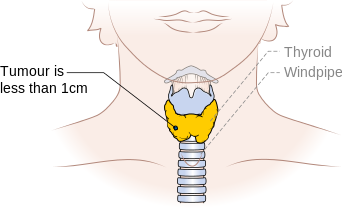 | |
| T1 | b | 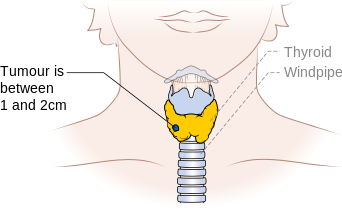 | |
| T2 | |||
| T3 | 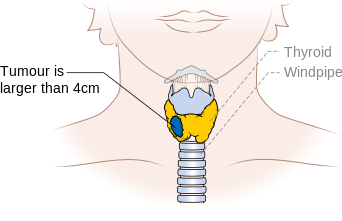 | ||
| T3 | a | ||
| T3 | b |
|
|
| T4 | |||
| T4 | a |
|
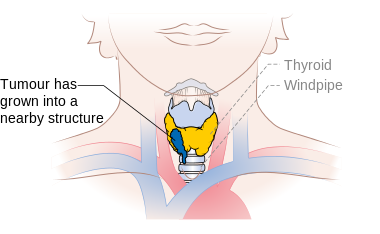 |
| T4 | b |
|
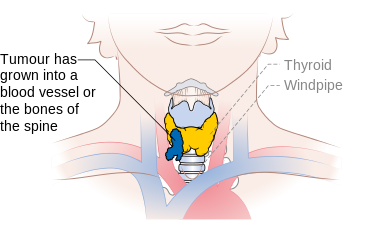 |
| TX |
|
||
| Regional lymph node involvement | |||
| Node involvement | Sub-stage | Finding | Image |
| N0 |
|
||
| N0 | a |
|
|
| N0 | b |
|
|
| N1 |
|
||
| N1 | a |
|
 |
| N1 | b |
|
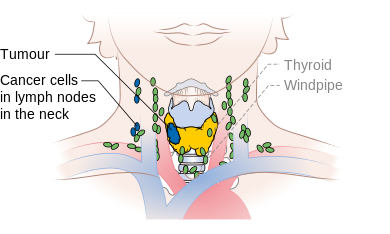 |
| NX |
|
||
| Distant metastasis | |||
| Presence of metastasis | Sub-stage | Finding | Image |
| M0 |
|
||
| M1 | IV |
|
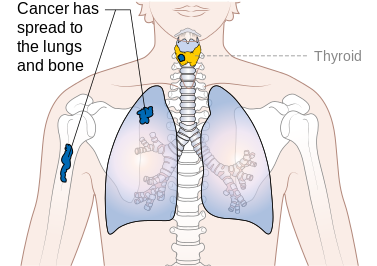 |
| Stage | T | N | M |
|---|---|---|---|
| IVA | T1–T3a | N0/NX | M0 |
| IVB | T1–T3a | N1 | M0 |
| T3b | Any N | M0 | |
| T4 | Any N | M0 | |
| IVC | Any T | Any N | M1 |
Reference
- ↑ Stage Information for Thyroid Cancer Cancer.gov (2015). http://www.cancer.gov/types/thyroid/hp/thyroid-treatment-pdq#link/stoc_h2_2- Accessed on October, 29 2015
- ↑ Thyroid Cancer Cancer.gov (2015). http://www.cancer.gov/types/thyroid/hp/thyroid-treatment-pdq#section/_6- Accessed on November, 19 2015